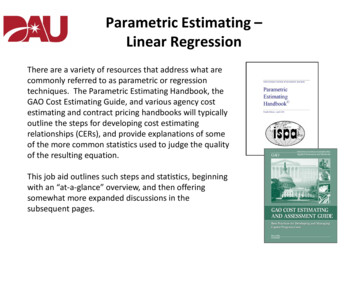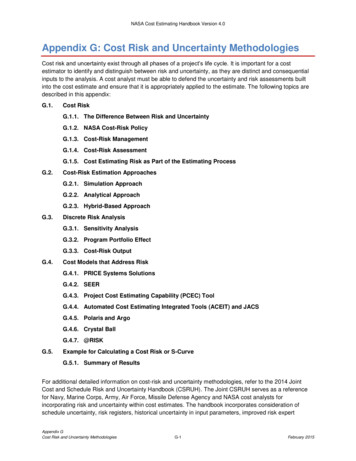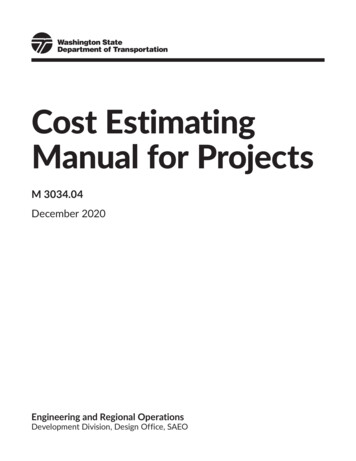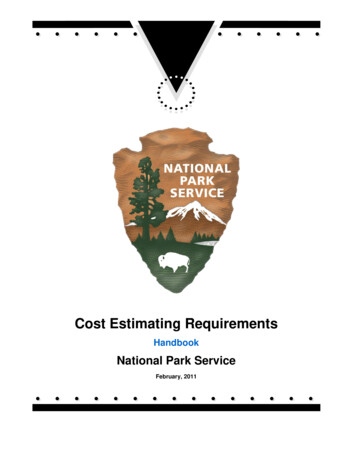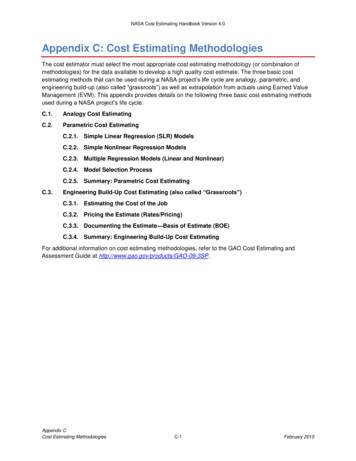
Transcription
NASA Cost Estimating Handbook Version 4.0Appendix C: Cost Estimating MethodologiesThe cost estimator must select the most appropriate cost estimating methodology (or combination ofmethodologies) for the data available to develop a high quality cost estimate. The three basic costestimating methods that can be used during a NASA project’s life cycle are analogy, parametric, andengineering build-up (also called “grassroots”) as well as extrapolation from actuals using Earned ValueManagement (EVM). This appendix provides details on the following three basic cost estimating methodsused during a NASA project’s life cycle:C.1.Analogy Cost EstimatingC.2.Parametric Cost EstimatingC.2.1. Simple Linear Regression (SLR) ModelsC.2.2. Simple Nonlinear Regression ModelsC.2.3. Multiple Regression Models (Linear and Nonlinear)C.2.4. Model Selection ProcessC.2.5. Summary: Parametric Cost EstimatingC.3.Engineering Build-Up Cost Estimating (also called “Grassroots”)C.3.1. Estimating the Cost of the JobC.3.2. Pricing the Estimate (Rates/Pricing)C.3.3. Documenting the Estimate—Basis of Estimate (BOE)C.3.4. Summary: Engineering Build-Up Cost EstimatingFor additional information on cost estimating methodologies, refer to the GAO Cost Estimating andAssessment Guide at http://www.gao.gov/products/GAO-09-3SP.Appendix CCost Estimating MethodologiesC-1February 2015
NASA Cost Estimating Handbook Version 4.0Figure C-1 shows the three basic cost estimating methods that can be used during a NASA project’s lifecycle: analogy, parametric, and engineering build-up (also called “grassroots”), as well as extrapolationfrom actuals using Earned Value Management (EVM).Figure C-1. Use of Cost Estimating Methodologies by Phase1When choosing a methodology, the analyst must remember that cost estimating is a forecast of futurecosts based on the extrapolation of available historical cost and schedule data. The type of costestimating method used will depend on the adequacy of Project/Program definition, level of detailrequired, availability of data, and time constraints. The analogy method finds the cost of a similar spacesystem, adjusts for differences, and estimates the cost of the new space system. The parametric methoduses a statistical relationship to relate cost to one or several technical or programmatic attributes (alsoknown as independent variables). The engineering build-up is a detailed cost estimate developed fromthe bottom up by estimating the cost of every activity in a project’s Work Breakdown Structure (WBS).Table C-1 presents the strengths and weaknesses of each method and identifies some of the associatedapplications.Defense Acquisition University, “Integrated Defense Acquisition, Technology, and Logistics Life Cycle Management Frameworkchart (v5.2),” 2008, as reproduced in the International Cost Estimating and Analysis Association’s “Cost Estimating Body ofKnowledge Module 2.”1Appendix CCost Estimating MethodologiesC-2February 2015
NASA Cost Estimating Handbook Version 4.0Table C-1. Strengths, Weaknesses, and Applications of Estimating MethodsMethodologyAnalogy uild-UpStrengthsWeaknessesApplicationsBased on actual historical dataIn some cases, relies on singlehistorical data pointQuickCan be difficult to identify appropriateanalogReadily understoodRequires "normalization" to ensureaccuracyAccurate for minor deviations fromthe analogRelies on extrapolation and/or expertjudgment for "adjustment factors" Early in the designprocess When less data areavailable In rough order-ofmagnitude estimate Cross-checking Architectural studies Long-range planningOnce developed, CERs are anexcellent tool to answer many"what if" questions rapidlyOften difficult for others to understandthe statistics associated with theCERsStatistically sound predictors thatprovide information about theestimator’s confidence of theirpredictive abilityMust fully describe and document theselection of raw data, adjustments todata, development of equations,statistical findings, and conclusionsfor validation and acceptanceEliminates reliance on opinionthrough the use of actualobservationsCollecting appropriate data andgenerating statistically correct CERsis typically difficult, time consuming,and expensiveDefensibility rests on logicalcorrelation, thorough anddisciplined research, defensibledata, and scientific methodLoses predictive ability/credibilityoutside its relevant data rangeIntuitiveCostly; significant effort (time andmoney) required to create a build-upestimate; Susceptible to errors ofomission/double countingDefensibleNot readily responsive to "what if"requirementsCredibility provided by visibility intothe BOE for each cost elementNew estimates must be "built up" foreach alternative scenarioSeverable; entire estimate is notcompromised by the miscalculationof an individual cost elementCannot provide "statistical"confidence levelProvides excellent insight intomajor cost contributors (e.g., highdollar items).Does not provide good insight intocost drivers (i.e., parameters that,when increased, cause significantincreases in cost)Reusable; easily transferable foruse and insight into individualproject budgets and performerschedulesRelationships/links among costelements must be "programmed" bythe analystAppendix CCost Estimating MethodologiesC-3 Design-to-cost tradestudies Cross-checking Architectural studies Long-range planning Sensitivity analysis Data-driven risk analysis Software development Production estimating Negotiations Mature projects Resource allocationFebruary 2015
NASA Cost Estimating Handbook Version 4.0C.1. Analogy Cost EstimatingNASA missions are generally unique, but typically few of the systems are completely new systems; theybuild on the development efforts of their predecessors. The analogy estimating method takes advantageof this synergy by using actual costs from a similar program with adjustments to account for differencesbetween the analogy mission and the new system. Estimators use this method in the early life cycle of anew program or system when technical definition is immature and insufficient cost data are available.Although immature, the technical definition should be established enough to make sufficient adjustmentsto the analogy cost data.Cost data from an existing system that is technically representative of the new system to be estimatedserve as the Basis of Estimate (BOE). Cost data are then subjectively adjusted upward or downward,depending upon whether the subject system is felt to be more or less complex than the analogoussystem. Clearly, subjective adjustments that compromise the validity and defensibility of the estimateshould be avoided, and the rationale for these adjustments should be adequately documented. Analogyestimating may be performed at any level of the WBS. Linear extrapolations from the analog areacceptable adjustments, assuming a valid linear relationship exists.Table C-2 shows an example of an analogy:Table C-2. Predecessor System Versus New System AnalogySolar ArrayPowerSolar Array CostPredecessor SystemNew SystemAB2.3 KW3.4 KW 10M?Assuming a linear relationship between power and cost, and assuming also that power is a cost driver ofsolar array cost, the single-point analogy calculation can be performed as follows:Solar Array Cost for System B 3.4/2.3 * 10M 14.8MComplexity or adjustment factors can also be applied to an analogy estimate to make allowances for yearof technology, inflation, and technology maturation. These adjustments can be made sequentially orseparately. A complexity factor usually is used to modify a cost estimate for technical difficulty (e.g., anadjustment from an air system to a space system). A traditional complexity factor is a linear multiplier thatis applied to the subsystem cost produced by a cost model. In its simplest terms, it is a measure of thecomplexity of the subsystem being priced compared to the single point analog data point being used.This method relies heavily on expert opinion to scale the existing system data to approximate the newsystem. Relative to the analog, complexities are frequently assigned to reflect a comparison of factorssuch as design maturity at the point of selection and engineering or performance parameters like pointingaccuracy, data rate and storage, mass, and materials. If there are a number of analogous data points,their relative characteristics may be used to inform the assignment of a complexity factor. It is imperativethat the estimator and the subject matter expert (SME) work together to remove as much subjectivity fromthe process as possible, to document the rationale for adjustments, and to ensure that the estimate isdefensible.Complexity or adjustment factors may be applied to an analogy estimate to make allowances for thingssuch as year of technology, inflation, and technology maturation. A complexity factor is used to modify thecost estimate as an adjustment, for example, from an aerospace flight system to a space flight systemdue to the known and distinct rigors of testing, materials, performance, and compliance requirementsAppendix CCost Estimating MethodologiesC-4February 2015
NASA Cost Estimating Handbook Version 4.0between the two systems. A traditional complexity factor is a linear multiplier that is applied to thesubsystem cost produced by a cost model. In its simplest terms, it is a measure of the complexity of thesubsystem being estimated compared to the composite of the cost estimating relationship (CER)database being used or compared to the single point analog data point being used.The following steps would generally be followed to determine the complexity factor. The cost estimator(with the assistance of the design engineer) would: Become familiar with the historical data points that are candidates for selection as the costinganalog; Select that data point that is most analogous to the new subsystem being designed; Assess the complexity of the new subsystem compared to that of the selected analog in terms of:–––Design maturity of the new subsystem compared to the design maturity of the analog when itwas developed;Technology readiness of the new design compared to the technology readiness of the analogwhen it was developed; andSpecific design differences that make the new subsystem more or less complex than theanalog (examples would be comparisons of pointing accuracy requirements for a guidancesystem, data rate and storage requirements for a computer, differences in materials forstructural items, etc.). Make a quantitative judgment for a value of the complexity factor based on the aboveconsiderations; and Document the rationale for the selection of the complexity factor.Table C-3 presents the strengths and weaknesses of the Analogy Cost Estimating Methodology andidentifies some of the associated applications.Table C-3. Strengths, Weaknesses, and Applications of Analogy Cost Estimating MethodologyStrengthsBased on actual historical dataWeaknessesIn some cases, relies on singlehistorical data pointQuickCan be difficult to identifyappropriate analogReadily understoodRequires "normalization" toensure accuracyAccurate for minor deviationsfrom the analogRelies on extrapolation and/orexpert judgment for "adjustmentfactors"Applications Early in the designprocess When less data areavailable In rough order-ofmagnitude estimate Cross-checking Architectural studies Long-range planningC.2. Parametric Cost Estimating2Parametric cost estimates are a result of a cost estimating methodology using statistical relationshipsbetween historical costs and other program variables (e.g. system physical or performanceThe information in this section comes from the GAO Cost Estimating and Assessment Guide – Best Practices for Developing andManaging Capital Program Costs, GAO-09-3SP, March 2009.2Appendix CCost Estimating MethodologiesC-5February 2015
NASA Cost Estimating Handbook Version 4.0characteristics, contractor output measures, or personnel loading) to develop one or more cost estimatingrelationships (CERs). Generally, an estimator selects parametric cost estimating when only a few keypieces of data are known, such as weight and volume. The implicit assumption in parametric costestimating is that the same forces that affected cost in the past will affect cost in the future. For example,NASA cost estimates are frequently of space systems or software. The data that relate to these estimatesare weight characteristics and design complexity, respectively. The major advantage of using aparametric methodology is that the estimate can usually be conducted quickly and be easily replicated.Figure C-2 shows the steps associated with parametric cost ession)AnalysisEvaluate &Normalize DataTestRelationshipsAnalyze Data hipFigure C-2. Parametric Cost Modeling ProcessIn parametric estimating, a cost estimator will either use NASA-developed, commercial off-the-shelf(COTS), or generally accepted equations/models or create her own CERs. If the cost estimator choosesto develop her own CERs, there are several techniques to guide the estimator.To develop a parametric CER, the cost estimator must determine the drivers that most influence cost.After studying the technical baseline and analyzing the data through scatter charts and other methods,the cost estimator should verify the selected cost drivers by discussing them with engineers, scientists,and/or other technical experts. The CER can then be developed with a mathematical expression, whichcan range from a simple rule of thumb (e.g., dollars per kg) to an equation having several parameters(e.g., cost as a function of kilowatts, source lines-of-code [SLOC], and kilograms) that drive cost.Estimates created using a parametric approach are based on historical data and mathematicalexpressions relating cost as the dependent variable to selected, independent, cost-driving variables.Generally, an estimator selects parametric cost estimating when only a few key pieces of data, such asweight and volume, are known. The implicit assumption of parametric cost estimating is that the sameforces that affected cost in the past will affect cost in the future. For example, NASA cost estimates arefrequently of space systems or software. The data that relates to estimates of these are weightcharacteristics and design complexity, respectively.Appendix CCost Estimating MethodologiesC-6February 2015
NASA Cost Estimating Handbook Version 4.0The major advantage of using a parametric methodology is that the estimate can usually be conductedquickly and be easily replicated. Most estimates are developed using a variety of methods where somegeneral principles apply.Note that there are many cases when CERs can be created without the application of regressionanalysis. These CERs are typically shown as rates, factors, and ratios. Rates, factors, and ratios are oftenthe result of simple calculations (like averages) and many times do not include statistics. A rate uses a parameter to predict cost, using a multiplicative relationship. Since rate is defined to becost as a function of a parameter, the units for rate are always dollars per something. The rate mostcommonly used in cost estimating is the labor rate, expressed in dollars per hour. Other commonlyused rates are dollars per pound and dollars per gallon. A factor uses the cost of another element to estimate a new cost using a multiplier. Since a factor isdefined to be cost as a function of another cost, it is often expressed as a percentage. For example,travel costs may be estimated as 5 percent of program management costs. A ratio is a function of another parameter and is often used to estimate effort. For example, the costto build a component could be based on the industry standard of 20 hours per subcomponent.Parametric estimates established early in the acquisition process must be periodically examined toensure that they are current throughout the acquisition life cycle and that the input range of data beingestimated is applicable to the system. Such output should be shown in detail and well documented. If, forexample, a CER is improperly applied, a serious estimating error could result. Microsoft Excel and othercommercially available modeling tools are most often used for these calculations. For more information onmodels and tools, refer to Appendix E.The remainder of the parametrics section will cover how a cost estimator applies regression analysis tocreate a CER and uses analysis of variance (ANOVA) to evaluate the quality of the CER.Regression analysis is the primary method by which parametric cost estimating is enabled. Regressionis a branch of applied statistics that attempts to quantify the relationship between variables and thendescribe the accuracy of that relationship by various indicators. This definition has two parts: (1)quantifying the relationship between the variables involves using a mathematical expression, and (2)describing the accuracy of the relationship requires the computation of various statistics that indicate howwell the mathematical expression describes the relationship between the variables. This chapter coversmathematical expressions that describe the relationship between the variables using a linear expressionwith only two variables. The graphical representation of this expression is a straight line. Regressionanalysis is the technique applied in the parametric method of cost estimating. Some basic statistics textsalso refer to regression analysis as the Least Square Best Fit (LSBF) method, also known as the methodof Ordinary Least Squares (OLS).The main challenge in analyzing bivariate (two variable) and multivariate (three or more variables) data isto discover and measure the association or covariation between the variables—that is, to determine howthe variables relate to one another. When the relationship between variables is sharp and precise,ordinary mathematical methods suffice. Algebraic and trigonometric relationships have been studiedsuccessfully for centuries. When the relationship is blurred or imprecise, the preference is to usestatistical methods. We can measure whether the vagueness is so great that there is no usefulrelationship at all. If there is only a moderate amount of vagueness, we can calculate what the bestprediction would be and also qualify the prediction to take into account the imprecision of the relationship.There are two related, but distinct, aspects of the study of association between variables. The first,regression analysis, attempts to establish the nature of the relationship between variables—that is, tostudy the functional relationship between the variables and thereby provide a mechanism for predicting orAppendix CCost Estimating MethodologiesC-7February 2015
NASA Cost Estimating Handbook Version 4.0forecasting. The second, correlation analysis, has the objective of determining the degree of therelationship between variables. In the context of this appendix, we employ regression analysis to developan equation or CER.If there is a relationship between any variables, there are four possible reasons.1. The first reason has the least utility: chance. Everyone is familiar with this type of unexpected andunexplainable event. An example of a chance relationship might be a person totally unfamiliarwith the game of football winning a football pool by correctly selecting all the winning teams. Thistype of relationship between variables is totally useless since it is unquantifiable. There is no wayto predict whether or when the person would win again.2. A second reason for relationships between variables might be a relationship to a third set ofcircumstances. For instance, while the sun is shining in the United States, it is nighttime inAustralia. Neither event caused the other. The relationship between these two events is betterexplained by relating each event to another variable, the rotation of Earth with respect to the Sun.Although many relationships of this form are quantifiable, we generally desire a more directrelationship.3. The third reason for correlation is a functional relationship, one which we represent by equations.An example would be the relationship: F ma, where F force, m mass, and a accelerationdue to the force of gravity. This precise relationship seldom exists in cost estimating.4. The last reason is a causal relationship. These relationships are also represented by equations,but in this case a cause-and-effect situation is inferred between the variables. It should be notedthat a regression analysis does not prove cause and effect. Instead, a regression analysispresents what the cost estimator believes to be a logical cause-and-effect relationship. It’simportant to note that each causal relationship enables the analyst to imply that the relationshipbetween variables is consistent. Therefore, two different types of variables will arise.a. There will be unknown variables called dependent variables designated by the symbol Y.b. There will be known variables called independent variables designated by the symbol X.c. The dependent variable responds to changes in the independent variable.d. When working with CERs, the Y variable represents some sort of cost, while the X variablesrepresent various parameters of the system.As noted above in #4, regression analysis is used not to confirm causality, but rather to infer causality.In other words, no matter the statistical significance of a regression result, causality cannot be proven.For example, assume a project designing a NASA launch system wants to know its cost based uponcurrent system requirements. The cost estimator investigates how well these requirements correlate tocost. If certain system requirements (e.g., thrust) indicate a strong correlation to system cost, and theseregressions appear logical (i.e., positive correlation), then one can infer that these equations have acausal relationship—a subtle yet important distinction from proving cause and effect. Although regressionanalysis cannot confirm causality, it does explicitly provide a way to (a) measure the strength ofquantitative relationships and (b) estimate and test hypotheses regarding a model’s parameters.Prior to performing regression analysis, it is important to examine and normalize the data as follows 3:(1) Make inflation adjustments to a common base year.(2) Make learning curve adjustments to a common specified unit, e.g., Cost of First Unit (CFU).(3) Check independent variables for extrapolation.(4) Perform a scatterplot analysis.3For more details on data normalization, refer to Task 7 (Gather and Normalize Data) in section 2.2.4 of the Cost EstimatingHandbook.Appendix CCost Estimating MethodologiesC-8February 2015
NASA Cost Estimating Handbook Version 4.0(5) Check for database homogeneity.(6) Check for multicollinearity.The first step of the actual regression analysis is to postulate what independent variable or variables (e.g.,a system’s weight, X) could have a significant effect on the dependent variable (e.g., a system’s cost, Y).This step is commonly performed by creating a scatterplot of the (X, Y) data pairs then “eyeballing” toidentify a possible trend. For a CER, the dependent variable will always be cost and each independentvariable will be a cost driver. Each cost driver should be chosen only when there is correlation between itand cost and because there are sound principles for the relationship being investigated. For example,given analysts assume that the complexity (X) of a piece of computer software drives the cost of asoftware development project (Y), the analysts can investigate their assumption by plotting historical pairsof these dependent and independent variables (Y versus X). Plotting this historical data of cost (Y) versusweight (X) produces a scatterplot as shown in Figure C-3.350–C O S TGiven weight (X) 675; cost (Y) 240300–250–240Regression CalculationY aX bY 0.355 * X 0.703Y 0.355 * 675 0.703 240200–5005506006507007508008509009501000W E I G H TFigure C-3. Scatterplot and Regression Line of Cost (Y) Versus Weight (X)The point of regression analysis is to “fit” a line to the data that will result in an equation that describesthat line, expressed by Y Y-intercept (slope) (X). In Figure C-1, we assume a positive correlation, onethat indicates that as weight increases, so does the cost associated with the weight. It is much lesscommon that a CER will be developed around a negative correlation, i.e., as the independent variableincreases in quantity, cost decreases. Whether the independent variable is complexity or weight orsomething else, there is typically a positive correlation to cost.The next step in performing regression analysis to produce a CER is to calculate the relationship betweenthe dependent (Y) and independent (X) variables. In other words, see if the data infer any reasonabledegree of cause and effect. The data are, in most cases, assumed to follow either a linear or nonlinearpattern. For the regression line in Figure C-1, the notional CER is depicted as a linear relationship of Cost A B * Weight.Appendix CCost Estimating MethodologiesC-9February 2015
NASA Cost Estimating Handbook Version 4.0As noted in the beginning of this section, the most widely used regression method is the OLS method,which can be applied for modeling both linear and nonlinear CERs (when having one independentvariable). Through the application of OLS, section C.2.1. provides details on how to model dependent andindependent variables in linear equation form, Y Y-intercept (slope) (X). OLS is used again in sectionC.2.2. to calculate nonlinear models of the form Y AXB. In order to apply OLS in section C.2.2. (on whatis thought to be a nonlinear trend), the nonlinear historical (X, Y) data is transformed using logarithms.Table C-4 serves as a reference for describing key symbols used in regression analysis. This summarytable includes not only symbols that make up a regression model but also important symbols used toassess these models.There are several other regression methods to produce nonlinear models that bypass the need totransform the historical (X, Y) data. These methods, which were developed to address limitationsassociated with OLS, include: Minimum Unbiased Percentage Error (MUPE) MethodZero Percent Bias/Minimum Percent Error (ZPB/MPE) Method (also known as ZMPE Method)Iterative Regression TechniquesSuch nonlinear regression methods are out of the scope of this handbook and, therefore, will not becovered in Appendix C. For more information on the MUPE Method, ZMPE Method, and IterativeRegression Techniques, refer to the “Regression Methods” section of Appendix A of the 2013 Joint Costand Schedule Risk and Uncertainty Handbook (CSRUH) at https://www.ncca.navy.mil/tools/tools.cfm.The remainder of Section C.2. covers the following steps in performing regression analysis and selectingthe best CER:(1) Review the literature and scatterplots to postulate cost drivers of the dependent variable.(2) Select the independent variables(s) for each CER.(3) Specify each model’s functional form (e.g., linear, nonlinear).(4) Apply regression methods to produce each CER.(5) Perform significance tests (i.e., t-test, F-test) and residual analyses.(6) Test for multicollinearity (if multiple regression).(7) See if equation causality seems logical (e.g., does the sign of slope coefficient make sense?).(8) For remaining equations, down-select to the one with highest R2 and/or lowest SE.(9) Collect additional data and repeat steps 1–8 (if needed).(10) Document the results.These steps begin with how to produce and assess a simple linear regression (SLR) model.Appendix CCost Estimating MethodologiesC-10February 2015
NASA Cost Estimating Handbook Version 4.0Table C-4. Summary of Key Symbols in Regression AnalysisSymbolDescriptionDefinitionX, YData ObservationsY dependent variableX independent variableX ,YAverage or MeanXYX i 's mean of actual Yi 's. mean of actualEvaluationCheck and correct any errors,especially outliers in the data. If dataquality is poor, it may be necessary toopt for an analysis method other thanregression.Helpful to describe the central tendencyof the data being evaluated Derived using SLR, YiCalculated YYiYiis the predictedXi ,and will differ from Yi whenever Yior “fitted” value associated with dependent variabledoes not lie on the regression line.Estimated Coefficientof Each IndependentVariable (i.e., eachestimated regressionparameter)Value of y-intercept, eachslope in a linear equation,and/or each exponent in anonlinear equationIf t-stats are below threshold or valuesseem illogical, re-specify the model(e.g., with other independent variablesand/or another functional form).eiError or “Residual”Difference between anactual Y (Yi) and itsrespective predicted Y (Y)Check for transcription errors. Takeappropriate corrective action.R2Coefficient ofDeterminationMeasures degree ofoverall fit of the model tothe dataThe closer R2 is to 100 percent, thebetter the fit.b i or BiR 2aR2Adjusted forDegrees of FreedomR2 formula is adjusted toaccount for contribution ofone or more additionalexplanatory variables.SSRSSESum of Squared TotalSum of SquaredRegression(Explained Error)Sum of SquaredErrors(Unexplained Error)SST SSR Σvariable is irrelevant is if the value(Yi – Y)2R 2agoes down when the explanatoryvariable is added to the equation.Used to compute R2 andnSSTOne indication that an explanatoryR 2a . Thei 1higher the SST, the more disperse theactual Y-data is from the mean of Y.nUsed to compute R2 andΣ(Yi – Y)2R 2a . Thei 1higher the SSR, the more “different” theregression line is from the mean of Y.nUsed to compute R2 and i )2SSE Σ (Yi – Yi 1R 2a . Thehigher the SSE, the more disperse thepredicted Y-data is from a
Power 2.3 KW 3.4 KW Solar Array Cost 10M ? Assuming a linear relationship between power and cost, and assuming also that power is a cost driver of solar array cost, the single-point analogy calculation can

